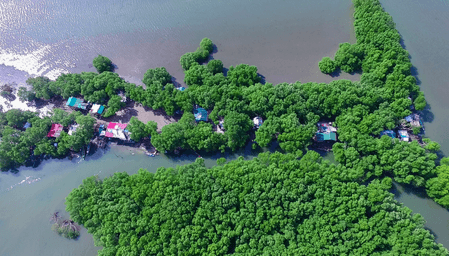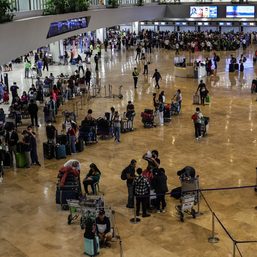SUMMARY
This is AI generated summarization, which may have errors. For context, always refer to the full article.

MANILA, Philippines – Filipino tycoon Ramon Ang and environmentalists spoke up on the flooding in Bulacan following weeks of heavy rain which inundated large parts of the Central Luzon province.
Flooding had already been a problem in Bulacan even before the construction of San Miguel Corporation’s (SMC) New Manila International Airport (NMIA), said Ang, president and CEO of one of the Philippines’ largest and most diversified conglomerates.
“There are many contributing factors to flooding. Bulacan has many low-lying areas,” Ang said in a statement on Wednesday, August 9. “Another is land subsidence caused by over-extraction and the depletion of ground water.”
“Degradation, siltation, and pollution of our rivers are of course major causes of flooding. Because of these, rivers become shallow and their flood carrying capacity is severely diminished, resulting in river overflow and floods. The proliferation of fish ponds in coastal areas has also contributed to severe flooding in the province,” he added.
He said SMC has started cleaning up rivers around the airport project site. SMC also invested in the Bulacan Bulk Water System Project years ago to provide potable water so that residents won’t have to “resort to unsustainable use of ground water,” Ang added.
Many environmental advocates have been pointing to the P740-billion aerotropolis project being built in an over 2,500-hectare property in Bulacan as one of the causes of flooding in large parts of the province.
Bulacan is considered a catch basin, prone to flooding during the monsoon season or when a typhoon hits – sometimes aggravated by the release of water of nearby dams.
Ang also said that the swamped towns of Calumpit and Hagonoy are “far from the airport project,” which is located in the town of Bulakan, Bulacan. Calumpit and Hagonoy, along with other towns like Paombong, San Miguel, and Malolos, suffered days of flooding in the aftermath of Typhoon Egay and the enhanced southwest monsoon rain.
Ang said the flooding in these areas were “affected by overflow from the heavily-silted Pampanga River aggravated by the release of water from some dams.”
Ang also said that SMC upholds the highest environmental standards in their projects.
“We would not pour in billions in resources if we didn’t consider all possible risks, including flooding in the province,” he said. “As with any major undertaking of this magnitude, extensive studies were done even before construction started.”
Amid the controversy on the recent suspension of Manila Bay reclamation projects, Ang also found it necessary to clarify that the NMIA is not a reclamation project.
Ang said they are only redeveloping existing land that has been inundated over time by natural processes and construction of fish ponds.
“The airport project does not involve reclamation,” said Ang in a statement on Friday, August 11. “The project site has existing, valid land titles indicating its original status as land…. Instead of creating new land, we are redeveloping it to its former state ensuring its productive and sustainable use for the future.”
Truly environmental conscious?
Environmentalists and a number of cause-oriented groups argued differently.
Flooding in Bulacan may be compounded by various factors such as ground subsidence, high tide, and topographical features. But “one cannot deny that putting a reclaimed land in nearby major rivers such as Meycauayan and Santa Maria would actually exacerbate flooding in affected communities,” Timothy James Cipriano, a senior lecturer at the Department of Geography of the University of the Philippines Diliman, said on Thursday, August 10.
“This reclaimed land where the Bulacan aerotropolis will rise would choke the flow of energy of the outflow of these rivers,” added Cipriano.
Another key concern is the damage to mangrove forests in Taliptip, Bulacan. Around 600 mangrove trees were cut down in 2018 at the airport site. Mangroves are crucial buffer zones that serve as the first line of defense against floods.
“The loss of mangroves may result in the worsening of the already ongoing flood problems present in Bulacan which has low-lying coastal areas,” youth organization Mangrove Matters PH said on Thursday.
SMC’s initiatives to plant mangrove trees will not solve this, the group said.
“It is best to protect the remaining mangroves and it is unsustainable to replace mature and century-old mangroves and plant them with mangrove seedlings which do not have a 100% chance of survival,” Mangrove Matters PH added.
The SMC chief said the conglomerate has started desilting and waste-extraction activities at the Meycauayan River and Maycapiz/Taliptip River.
Ang said SMC has cleaned up around 4.45 kilometers out of an initial 13-kilometer target along the Taliptip/Maycapiz River and the Meycauayan River. A total of 543,266 metric tons of silt and solid waste have been removed, he said.
Ang said they are already looking at expanding this initiative beyond Bulacan’s rivers and to other tributaries in Central Luzon. He said SMC will use its experience in cleaning the Pasig River and Tullahan River in this effort, citing the more than two million tons of silt and waste removed from these two tributaries.
The New Manila International Airport Project, an undertaking by San Miguel Holdings Corporation subsidiary San Miguel Aerocity Incorporated (SMAI), seeks to solve air traffic congestion in the country’s main gateway Ninoy Aquino International Airport, which breached its capacity of 31 million passengers years ago.
The NMIA will have an initial capacity of 35 million passengers annually, possibly by 2027, and is targeting 100 million passengers per year once fully completed.
It will have airfield facilities, terminal building, airport and airline support facilities, access roads, parking facilities, utilities, airport city, and other ancillary facilities.
The Philippine government signed a concession agreement with San Miguel for the NMIA after Congress granted it in January 2021 a franchise to operate a domestic and international airport in Bulacan. The P740-billion project is the Philippines’ single largest investment to date. – Rappler.com
1 comment
How does this make you feel?

![[OPINION] The new ‘Aerotropolis’: A double-edged sword](https://www.rappler.com/tachyon/2021/01/taliptip-january-12-2021.jpg?fit=449%2C449)















When Money (in terms of P 740 Billion investment) speaks, it certainly has its way. So for the residents who will be affected by flooding, just bear it or seek another place to live.